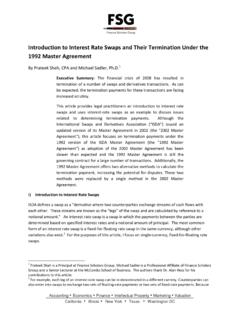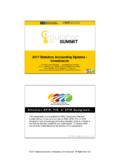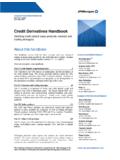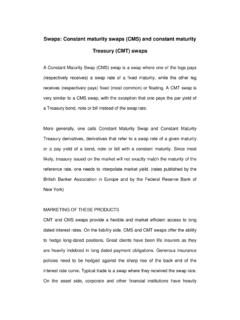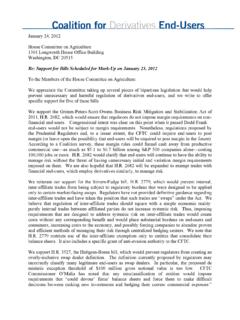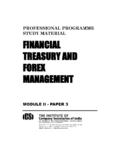Transcription of Interest Rate Swaps: Accounting vs. Economics A
1 Financial Analysts Journal Volume 63 Number 2. 2007, CFA Institute PE RS PE C T IVE S. Interest Rate swaps : Accounting vs. Economics Ira G. Kawaller A. lthough Accounting rules undergo virtually swap results are recorded in earnings but so ongoing review and adjustment, the genesis also is the change in the value of the debt being of the current framework is Statement of hedged because of the risk being Financial Accounting Standards (FAS) No. For most nontrading companies that use 133, Accounting for Derivative Instruments and Hedging derivatives to manage Interest rate risk, qualifying Activities, which was originally issued in June 1998. for and applying cash flow or fair value hedge Prior to this statement, Interest rate swaps had been Accounting is vital. With hedge Accounting , gains/. off balance sheet meaning that swap market val- losses from derivatives are sure to be recognized ues were not at all transparent.
2 FAS 133 changed that in earnings concurrently with the Interest treatment by requiring all qualifying derivatives expenses or revenues associated with the risks ( swaps included) to be recorded on the balance sheet being hedged. Without hedge Accounting , the two at fair value. How (and where) changes in values of income effects are likely to occur in different these swaps are to be recorded depends on their Accounting periods. Whether hedge Accounting is intended use and other technical considerations. used or not, the same aggregate income will ulti- Three alternatives are possible:1 mately be reported, but period-by-period income 1. If the swap was used for trading purposes (or volatility will undoubtedly be mitigated under if it was not specifically documented to be a hedge Accounting . All else being equal, managers, hedging contract), gains or losses are to be owners, and analysts concur that lower reported reported in earnings.
3 Income volatility results in lower stock price vol- 2. If the swap qualifies for cash flow hedge account- atility and a higher multiple. The preference for ing, which is likely to be the case if the swap hedge Accounting , then, is understandable. was being used to transform a floating- Interest - rate exposure to a fixed- Interest -rate exposure, To qualify for hedge Accounting , reporting the Accounting treatment requires a compari- entities have to document their hedges and meet a son of the derivative's performance with that series of specific requirements. In particular, pre- of an ideal ( , a hedge that perfectly offsets parers must provide justification for expecting that the effects of the risk being hedged).2 On the the hedges will offset changes in fair values or cash one hand, effective results are gains (or losses) flows of the associated hedged items due to the of the actual derivative equal in magnitude to risks being hedged.
4 When the derivative is struc- or less than the ideal gain (or loss). These tured to address a specific risk, you might expect results are initially recorded in other compre- preparing such documentation and meeting the hensive income (OCI, a component of equity) requirements to be a trivial exercise. But you would and later reclassified to earnings, coincidently be in for a surprise. with the earnings impact associated with the hedged item ( , the cash flow being hedged). The Shortcut Treatment On the other hand, ineffective swap results ( , The FASB clearly thought about this issue in con- gains or losses generated by the swap in excess nection with the use of Interest rate swaps and of the ideal) are recorded directly in allowed for a special shortcut treatment when the 3. If the swap is designated a fair value hedge, critical terms of the swap match those of the debt.
5 Which is likely if the swap is used to convert For the critical terms to be matching, the swap must from a fixed rate to a floating rate, the total be tailored to reflect the features of the instrument being hedged. Among other things, the swap's Ira G. Kawaller is president of Kawaller & Company, notional amount would match the debt's principal. LLC, and managing partner of the Kawaller Fund, Also, the accrual periods and reset periods of the Brooklyn, New York. swap and the debt would be the same. March/April 2007 15. Copyright 2007, CFA Institute. Reproduced and republished from the Financial Analyst Journal with permission from CFA Institute. All rights reserved. Financial Analysts Journal Applying the shortcut method serves to ensure the expected future cash flows of the variable cash the desired matching of hedge gains/losses with flows that were designated the hedged item, the those associated with the earnings impact of the assertion can (and should) be made that the swap hedged items and does so with less onerous is identical to a hypothetical derivative the per- Accounting calculations and documentation than fect hedge for the designated exposure.
6 As such, would otherwise be required. In particular, quali- unless and until any aspects of the hedged item fying for the shortcut method eliminates the need change, this swap will be perfectly effective at off- to specify and carry out tests of effectiveness. More- setting cash flows without reliance on the short- over, because perfect effectiveness may be cut election. That is, exactly the same Accounting assumed, the issue of measuring effectiveness also entries as those of the shortcut entry will result. becomes moot. The same cannot be said, however, for fair For the most part, qualifying for the shortcut value hedges. For one thing, the long-haul method simply requires documenting that the critical terms for fair value hedges requires a different calculation of the swap match those of the associated exposure. from that required by the shortcut.
7 Specifically, in With that documentation in place, the shortcut the shortcut method, the adjustment to the carrying Accounting treatment ends up providing synthetic value of the hedged item is determined as a func- instrument Accounting . That is, swapping from tion of the swap's results. In the long-haul method, fixed to floating fosters a posthedge Interest the reporting entity must independently determine expense or revenue that replicates that which the value change in the hedged item due solely to would arise from a variable-rate security; con- changes in the benchmark rate a calculation that is versely, swapping from floating to fixed generates by no means trivial. a fixed amount of reported Interest income/ Even more of a problem is that with fair value expense per period. hedges, even though the swap perfectly satisfies the Unfortunately, a number of companies economic objective of exchanging future fixed cash perhaps most prominently, Fannie Mae (Federal flows for future variable cash flows, to be effective in National Mortgage Association) claimed the abil- an Accounting sense, an alternative objective must ity to apply the shortcut treatment but the SEC be satisfied.
8 The swap must generate a gain or loss disagreed. The outcome (required by FAS 133) was that perfectly offsets the change in the value of the that these companies had to restate earnings to dis- debt resulting from the observed change in the allow hedge Accounting altogether. Clearly, the SEC benchmark Interest rate ( , the change in the was sending a message. It could have overridden LIBOR-based swap rate). In fact, the FASB seems to FAS 133 and denied the shortcut but still allowed be unconcerned that the swap was never designed hedge Accounting carried out in the long haul to perform in this fashion. Indeed, in the general procedures ( , regular cash flow or fair value case, the equivalency that the FASB seems to be hedge processing). In that case, in all likelihood, a looking for would not occur. The reason these two relatively minor adjustment to reported earnings effects should be expected to differ is that different would have resulted.
9 Rather, the SEC came across discount rates are prescribed for valuing the gains/. loud and clear in support of the FASB rules: Inade- losses for, respectively, the swap and the hedged quate or incorrect documentation disallows the abil- Thus, even though the exactly correct future ity to apply hedge Accounting period. cash flows are generated by the swap, the two Not surprisingly, this posture caused many respective present value changes will generally not companies to take a fresh look at their documen- be Under FAS 133, differences between tation and hedge effectiveness testing and mea- these two effects are considered to be ineffective. surement procedures. Many companies have And if the ineffectiveness is sufficiently large, hedge eschewed the shortcut option and elected instead Accounting may be disallowed even though the to apply the long-haul method.
10 By doing so, they hedge is working perfectly in an economic sense. believe they can reduce the prospect of being denied hedge Accounting because a condition for the shortcut treatment has been inadvertently Living with the Current Rules overlooked or violated. Operating under the current posture of the stan- Forgoing the shortcut treatment has little dard, hedgers should at least understand the differ- impact on cash flow hedges ( , when the objective ence between structuring a hedge designed to offset is to swap from floating to fixed). That is, if the future cash flows and structuring a hedge to offset swap is structured to reflect the best estimates of changes in fair values. These two objectives require 16 2007, CFA Institute Interest Rate swaps different hedges. In the first case, the swap's rate risk management application that relates to notional amount should match the principal of the future cash flows irrespective of whether those debt being hedged, but companies that structure cash flows are fixed or variable.
